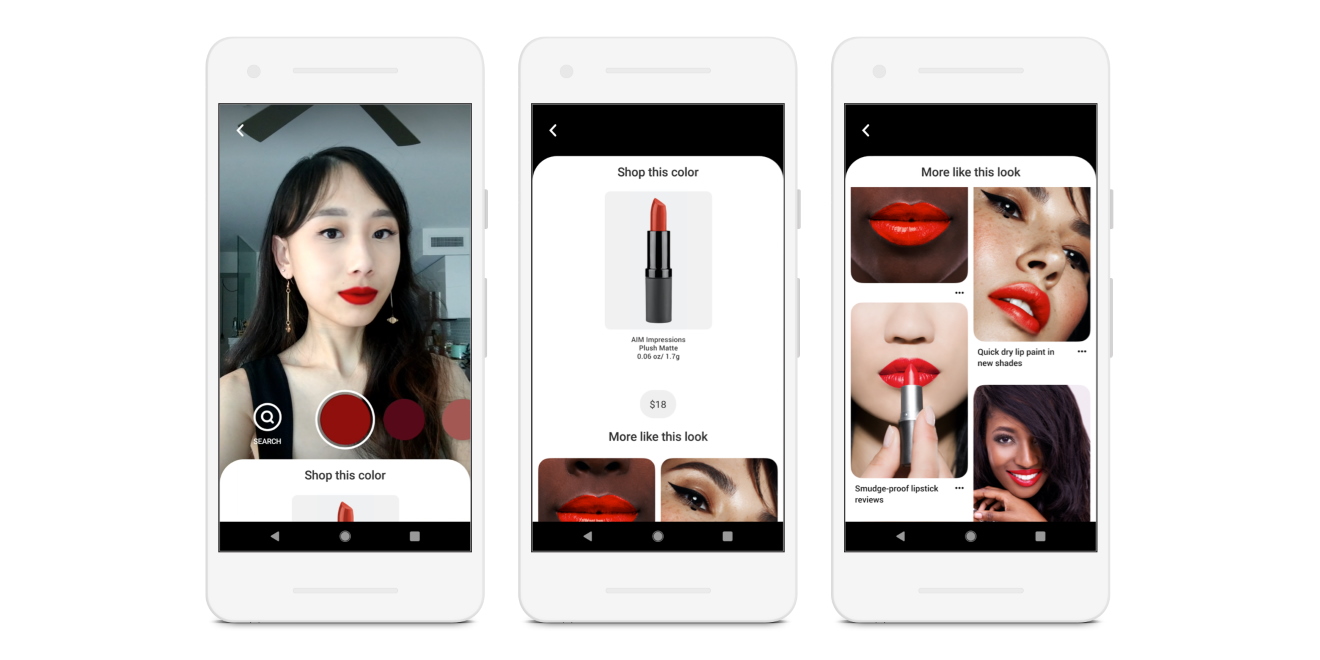Pinterest Debuts AR Try On in an Ecommerce Play
In a new ecommerce push, Pinterest has now introduced an augmented reality lipstick try-on feature that is powered by its Lens visual search tool. The feature will be available to lipstick shoppers in the U.S.

This is Pinterest’s latest play in ecommerce. The tool is known as “Try On Powered by Lens” and makes use of a selfie camera to enable users try on various lipstick shades. It shows them how specific lipsticks will look on their lips and the AR app adjusts to their movements in real time. It enables users to try out various lipstick shades as well as brands including Sephora, L’Oreal, Estee Lauder, and Neutrogena. They are subsequently able to swipe up and purchase the lipstick on the brand’s website.
This is Pinterest’s first augmented reality feature and it may as well open the floodgates for similar applications. Augmented reality is currently making waves in the U.S and around the world. An estimated 68.7 million people in the U.S. currently use augmented reality at least once a month. The Pinterest AR feature is building on its current computer vision capabilities including the Lens tool that was added three years ago which powers visual search on the platform and can even match items found in its catalogue to photos.
Snapchat and Instagram are still ahead of the game when it comes to AR integration onto their platforms. This has seen both platforms being adopted in the beauty and fashion augmented reality filters which are very popular with many shoppers. Pinterest move into AR also coincides with its current push to monetize its more than 86 million users. It has more users than Snapchat which currently has 83 million users. According to eMarketer, only Facebook and Instagram have more users than Pinterest.
Pinterest wants to leverage its advantage which is at the intersection of inspiration and shopping. Users generally visit Pinterest when they are considering purchasing something but they are still unsure or undecided. Pinterest serves as an ideas marketplace where they can sample out various ideas before they finally make the call.
In the US alone, some 52 million people search for beauty-related content on Pinterest every month, according to stats provided by the company. For brands, this represents an opportunity to engage with consumers who are still undecided and are open to new ideas. Pinterest hopes that by positioning augmented reality try-ons as a practical part of their shopping/purchasing journey, customers are able to see an accurate representation of what the product would actually look like. As a result, in the integration of the AR Try On, Pinterest decided against beautifying the user’s appearance by adding eyelashes, smoothing the skin or using some of the effects and filters commonly found in the face filters in the other social media platforms like Instagram. Pinterest wants to end users to get what they bargained for such that when they finally purchase the product, they see the result that they expect to see from their erstwhile experience with the AR Try-On tool.
The Pinterest Try On is currently available to all brands in a bid to encourage more AR Try Ons on the platform. It is not tied up to any specific ad campaign. Any brand can freely add their product catalogues to the tool. However, they will still require the technical sills to make AR-enabled versions of their merchandise. At the moment, the Try On-enabled Pjns cannot be used as ads. Pinterest plans to share with the brands data on how users will be engaging with the tool. This data will include insights and metrics such as the number of try-ons, impressions as well as the clickthrough rates. This is a more liberal approach to the sharing of user analytics. Facebook only shares its data with its advertisers.
Facebook’s approach is logical, though. Both Facebook and Instagram have a critical scale of users so they can afford to limit their special features only to advertisers that are spending on the platform. Pinterest, however, is still a fledgling player and hopes to build more AR-enabled content on the platform by giving all brands access to its special features.
Pinterest wants to make this process an incremental one instead of simply jumping into fads. It’s playing the long game that should materialize in a couple of years.
Pinterest hadn’t forayed into augmented reality because the realism of its technology was still not good enough. Now it is planning to add other AR product try-ons such as furniture and clothing once the quality of the technology improves to a level where it can deliver more realistic impressions. However, the jewelry try-ons are set to be launched soon.
https://virtualrealitytimes.com/2020/01/29/pinterest-debuts-ar-try-on-in-an-ecommerce-play/https://virtualrealitytimes.com/wp-content/uploads/2020/01/Pinterest-AR-Try-Ons-600x300.jpghttps://virtualrealitytimes.com/wp-content/uploads/2020/01/Pinterest-AR-Try-Ons-150x90.jpgAugmented RealityTechnologyIn a new ecommerce push, Pinterest has now introduced an augmented reality lipstick try-on feature that is powered by its Lens visual search tool. The feature will be available to lipstick shoppers in the U.S. This is Pinterest's latest play in ecommerce. The tool is known as “Try On Powered...Sam OchanjiSam Ochanji[email protected]EditorVirtual Reality Times - Metaverse & VR
